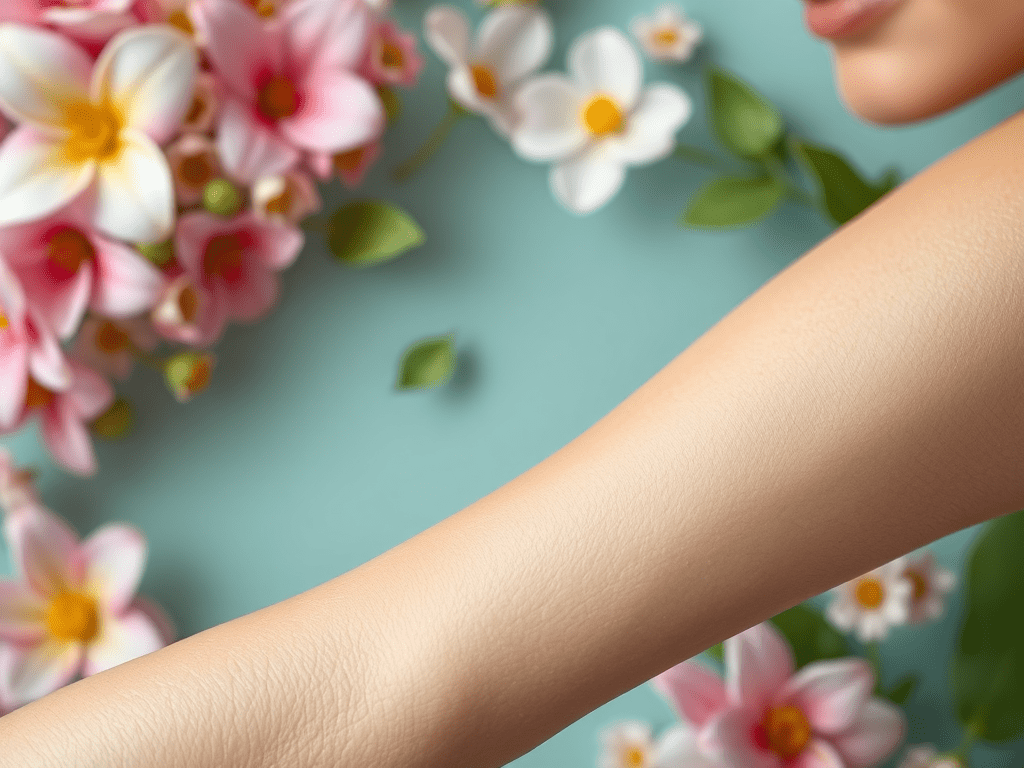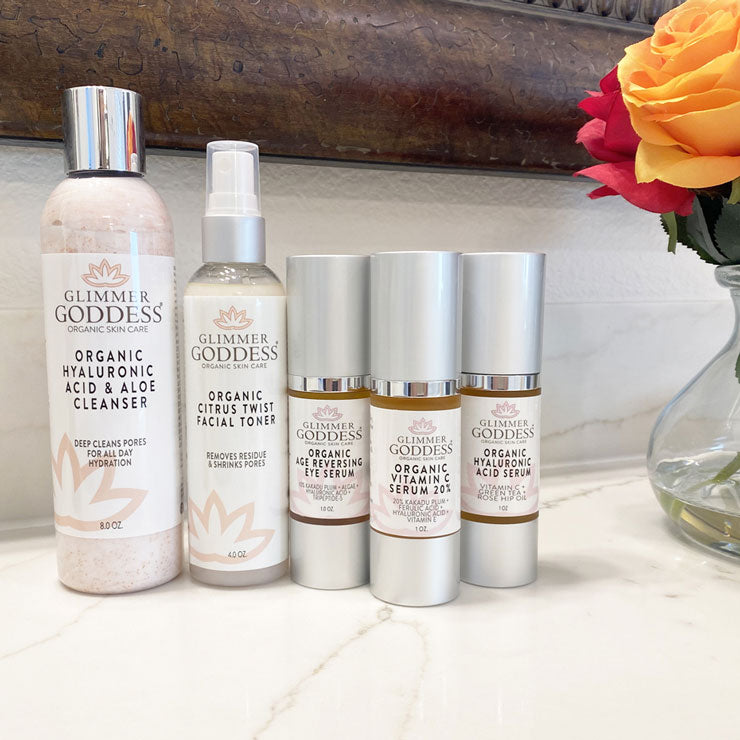
How to Get Rid of Crepey Skin, Glowing Skin with Our Luxurious Body Scrubs 💫
Crepey skin is a common concern for many as it reflects aging and environmental damage. In this blog, we will explore the key causes of crepey skin and reveal five effective steps to combat this condition. By implementing these strategies, you can revitalize your skin, boost its elasticity, and restore your youthful glow.
The Secret to Smooth, Youthful Skin: Understanding and Tackling Crepey Skin
What is Crepey Skin?
Crepey skin, a common yet often misunderstood skin condition, is characterized by thin, delicate, and wrinkled skin that resembles the texture of crepe paper. This skin type is typically found on areas of the body that are prone to sun exposure and natural aging, such as the neck, arms, and legs.
Crepey skin is a result of a complex interplay between various factors, including loss of elasticity, decreased collagen production, and environmental stressors. As we age, our skin naturally loses its ability to bounce back and maintain its youthful, supple appearance.
- The gradual breakdown of elastin and collagen fibers within the skin's structure leads to a loss of tension and support, causing the skin to become thin, lax, and wrinkled.
- Exposure to UV radiation from the sun can accelerate this process, further damaging the skin's underlying structure and exacerbating the appearance of crepey skin.
- Dehydration and lifestyle factors, such as smoking and poor diet, can also contribute to the development of crepey skin by compromising the skin's overall health and regenerative capabilities.
What are the Common Causes of Crepey Skin?
Understanding the underlying causes of crepey skin is the first step towards finding effective solutions to improve the appearance and texture of the skin.
There are several key factors that can contribute to the development of crepey skin:
- Aging: As we get older, our skin naturally loses elasticity and collagen, leading to a decrease in skin firmness and an increase in wrinkles and fine lines.
- Sun Exposure: Prolonged and unprotected exposure to UV radiation can cause significant damage to the skin, accelerating the breakdown of collagen and elastin fibers.
- Weight Fluctuations: Rapid weight loss or gain can cause the skin to lose its elasticity, leading to the formation of crepey skin, particularly on the arms, abdomen, and thighs.
- Genetics: Some individuals may be predisposed to developing crepey skin due to their genetic makeup and inherent skin structure.
- Hormonal Changes: Significant hormonal shifts, such as those experienced during menopause, can contribute to the thinning and loss of elasticity in the skin.
Who is Most Likely to Experience Crepey Skin?
While crepey skin can affect individuals of all ages, certain demographics are more susceptible to developing this skin condition.
The following groups are more likely to experience crepey skin:
- Older Adults: As people age, the natural aging process leads to a decrease in collagen and elastin production, making older adults more prone to developing crepey skin.
- Women: Hormonal changes, particularly during and after menopause, can contribute to a decline in skin elasticity and the appearance of crepey skin.
- Individuals with Sun-Damaged Skin: Those who have had extensive exposure to UV radiation, either through recreational activities or occupational environments, are at a higher risk of developing crepey skin.
- Those with Significant Weight Fluctuations: Rapid weight loss or gain can cause the skin to lose its ability to bounce back, leading to the formation of crepey skin.
- Smokers: Smoking can accelerate the aging process and contribute to the breakdown of collagen and elastin fibers, increasing the risk of crepey skin.
Understanding the causes and demographics of crepey skin is the first step towards developing an effective skincare routine and lifestyle habits to combat this common skin concern. By addressing the underlying factors and adopting targeted treatments, individuals can take proactive steps to maintain the skin's youthful appearance and texture.
The Key to Youthful, Supple Skin: A Comprehensive Guide
How can moisturizers help rejuvenate crepey skin?
Moisturizers are the foundation for maintaining healthy, youthful-looking skin. When it comes to crepey skin, the right moisturizer can make all the difference.
Crepey skin, characterized by thin, wrinkled, and dry-looking texture, is a common concern as we age. Fortunately, the right moisturizer can help rejuvenate and plump up this delicate skin.
- Humectant-rich moisturizers, such as those containing glycerin or hyaluronic acid, draw moisture into the skin and prevent water loss.
- Emollient-based moisturizers, like those with shea butter or ceramides, help seal in that hydration and smooth the appearance of crepey skin.
- Regular use of a nourishing, creamy moisturizer can over time improve the skin's elasticity and reduce the visible signs of crepiness.
- Applying moisturizer immediately after cleansing, when the skin is still damp, can maximize its effectiveness in locking in hydration.
- Look for moisturizers formulated with antioxidants, such as vitamin C or green tea, to further support skin health and rejuvenation.
- Gently massaging the moisturizer into the skin can also help stimulate circulation and promote a more youthful, plump appearance.
Incorporating a rich, hydrating moisturizer into your daily routine is a simple yet powerful step towards reviving crepey skin and restoring a more vibrant, supple complexion.
What role does diet play in skin health?
The foods and nutrients we consume have a profound impact on the health and appearance of our skin, including its ability to combat crepiness.
A balanced, nutrient-dense diet is crucial for maintaining the skin's structure, elasticity, and overall radiance.
- Healthy fats, such as those found in avocados, nuts, and fatty fish, nourish the skin's lipid barrier and promote suppleness.
- Antioxidant-rich foods, including berries, leafy greens, and tomatoes, help neutralize free radicals that can contribute to premature aging and crepey skin.
- Collagen-boosting nutrients, like vitamin C, zinc, and copper, support the skin's natural regeneration and firmness.
- Staying hydrated by drinking plenty of water is also essential for skin health, as it helps maintain the skin's moisture levels and elasticity.
- Limiting processed foods, sugar, and excessive alcohol consumption can further help mitigate inflammation and oxidative stress that can exacerbate crepey skin.
- Incorporating probiotic-rich foods, such as yogurt or kimchi, can also support the gut-skin connection and overall skin health.
By nourishing your body with a diverse array of nutrient-dense whole foods, you can give your skin the building blocks it needs to maintain a youthful, supple appearance and reduce the visible signs of crepiness.
Why is sun protection crucial for preventing crepey skin?
Unprotected sun exposure is one of the primary culprits behind the development of crepey skin, making consistent and effective sun protection a crucial step in maintaining healthy, youthful-looking skin.
Ultraviolet (UV) radiation from the sun is a major contributor to the breakdown of collagen and elastin, the two key structural proteins that keep our skin firm and resilient.
- Over time, cumulative sun damage can lead to the thinning and loss of these essential skin components, resulting in the characteristic wrinkled, sagging appearance of crepey skin.
- UV exposure also triggers the production of free radicals, which can further accelerate the aging process and exacerbate crepiness.
- Additionally, sun damage can disrupt the skin's natural moisture balance, leaving it dry, dehydrated, and more prone to developing a crepey texture.
- Applying a broad-spectrum sunscreen with an SPF of 30 or higher, and reapplying it every two hours when spending time outdoors, is crucial for protecting the skin from harmful UV rays.
- Wearing protective clothing, such as wide-brimmed hats and long-sleeved shirts, can also help shield the skin from sun exposure and prevent the development of crepey skin.
- Seeking shade during the peak sun hours, between 10 am and 4 pm, can further minimize the skin's exposure to damaging UV radiation.
Incorporating consistent, diligent sun protection into your daily routine is one of the most effective ways to maintain the skin's firmness, elasticity, and youthful appearance, and prevent the unwanted signs of crepiness over time.
Can retinoids renew your skin?
Retinoids, a class of vitamin A derivatives, are widely recognized for their ability to improve the appearance of crepey skin and promote a more youthful, radiant complexion.
These powerful skincare ingredients work by stimulating cellular turnover, boosting collagen production, and improving the skin's overall texture and tone.
- Retinoids help thicken the epidermis, the outermost layer of the skin, which can visibly reduce the appearance of crepiness and fine lines.
- By enhancing the skin's natural exfoliation process, retinoids can also help minimize the buildup of dead skin cells that can contribute to a dull, crepey appearance.
- Increased collagen production, stimulated by retinoids, helps plump and firm the skin, diminishing the visible signs of crepiness over time.
- It's important to start with a low-strength retinoid and gradually increase the concentration to allow your skin to adjust and avoid potential irritation.
- Incorporating retinoids into your nighttime routine is generally recommended, as they can make the skin more sensitive to sunlight.
- Pairing retinoids with hydrating, nourishing ingredients can help mitigate any dryness or flakiness that may occur, especially during the initial adjustment period.
By incorporating a retinoid-based product into your skincare regimen, you can harness the power of this versatile ingredient to revive crepey skin, boost collagen, and achieve a more youthful, radiant complexion.
How does hydration improve skin texture?
Maintaining optimal hydration levels is crucial for the health and appearance of our skin, including its ability to combat crepiness.
When the skin is adequately hydrated, it appears plump, smooth, and youthful. Conversely, dehydration can contribute to the development of crepey, wrinkled skin.
- Adequate hydration helps maintain the skin's natural barrier function, preventing transepidermal water loss and keeping the skin supple and resilient.
- Proper hydration also supports the skin's natural exfoliation process, helping to slough off dead, flaky cells that can accentuate the appearance of crepiness.
- Increased skin hydration can improve the skin's elasticity, reducing the visible signs of sagging and crepiness over time.
- Drinking plenty of water throughout the day is an essential first step in keeping the skin hydrated from the inside out.
- Incorporating hydrating, humectant-rich skincare products, such as serums and moisturizers containing ingredients like hyaluronic acid, can further boost the skin's moisture levels.
- Limiting exposure to factors that can strip the skin of its natural oils, such as hot showers, harsh cleansers, and environmental stressors, can also help maintain optimal hydration.
By prioritizing hydration through a comprehensive approach, you can help restore the skin's suppleness, minimize the appearance of crepiness, and achieve a more youthful, radiant complexion.
The key to combating crepey skin lies in a multifaceted approach that includes nourishing moisturizers, a nutrient-dense diet, consistent sun protection, targeted retinoid use, and a focus on maintaining optimal hydration levels. By incorporating these strategies into your skincare routine and lifestyle, you can revive the skin's firmness, elasticity, and overall radiance, reclaiming a more youthful, supple complexion.
Unraveling the Secrets to Smooth, Youthful Skin: Effective Dermatological Treatments for Crepey Skin
What are the most effective dermatological treatments for crepey skin?
As we age, our skin can lose its elasticity and firmness, leading to the dreaded appearance of crepey skin. This delicate, paper-thin texture can be a source of frustration, but the good news is that there are several effective dermatological treatments available to combat this common skin concern.
Crepey skin is a result of a combination of factors, including decreased collagen production, loss of elasticity, and environmental stressors. Fortunately, modern dermatology offers a range of solutions to address this condition and restore a smoother, more youthful appearance.
- Retinoids: These vitamin A derivatives are known for their ability to stimulate collagen production and improve skin texture. Prescription-strength retinoids, such as tretinoin, can be particularly effective in treating crepey skin.
- Hydrating Skincare: Incorporating deeply nourishing and moisturizing products into your daily routine can help plump and smooth crepey skin. Look for ingredients like hyaluronic acid, ceramides, and glycerin to lock in moisture and improve the skin's barrier function.
- Exfoliation: Regular gentle exfoliation, either physical or chemical, can help slough off dead skin cells and promote cell turnover, revealing a smoother, more youthful complexion.
How do chemical peels benefit crepey skin?
Chemical peels are another powerful tool in the fight against crepey skin. These treatments use a combination of acids to gently remove the outermost layer of the skin, stimulating the production of new, healthier cells.
Chemical peels can be a game-changer for crepey skin, offering a range of benefits:
- Improved Skin Texture: The exfoliating action of chemical peels can help smooth out the rough, uneven texture of crepey skin, revealing a more refined and even appearance.
- Enhanced Collagen Production: Many chemical peel formulas contain ingredients like alpha-hydroxy acids (AHAs) and retinoids, which can boost collagen synthesis and improve skin elasticity.
- Reduced Appearance of Fine Lines and Wrinkles: By stimulating cellular turnover and collagen production, chemical peels can help diminish the visible signs of aging, including fine lines and wrinkles.
- Brighter, More Radiant Complexion: The resurfacing effects of chemical peels can result in a more luminous, youthful-looking complexion.
What is the impact of laser therapy?
Laser treatments have also emerged as a highly effective solution for addressing crepey skin. These advanced technologies can target the underlying causes of this skin concern with precision and accuracy.
Laser therapies offer a range of benefits for crepey skin:
- Collagen Stimulation: Certain laser treatments, such as fractionated CO2 lasers and radiofrequency devices, can stimulate the production of new collagen fibers, improving skin elasticity and firmness.
- Skin Tightening: The heat generated by laser energy can trigger a natural healing response, leading to the contraction and tightening of the skin.
- Resurfacing: Ablative laser treatments can remove the uppermost layer of damaged skin, revealing a smoother, more even complexion.
- Improved Texture: The combination of collagen stimulation and resurfacing can result in a more refined, youthful-looking skin texture.
Are fillers and injectables a good option?
In addition to traditional dermatological treatments, injectable solutions have also become increasingly popular for addressing crepey skin. Fillers and neurotoxins can offer a complementary approach to improving skin quality and texture.
Fillers and injectables can be a valuable addition to a comprehensive crepey skin treatment plan:
- Hyaluronic Acid Fillers: These injectable gels can help plump and hydrate crepey skin, temporarily improving the appearance of fine lines and wrinkles.
- Collagen Stimulators: Injectables like Sculptra and Radiesse can stimulate the body's natural collagen production, leading to long-term improvements in skin elasticity and firmness.
- Neurotoxins: Treatments like Botox can relax the underlying muscles, reducing the appearance of dynamic wrinkles and creating a smoother, more youthful complexion.
How to choose the right professional treatment?
When it comes to addressing crepey skin, it's crucial to work with a qualified and experienced dermatologist or aesthetic professional. They can assess your individual skin concerns and develop a customized treatment plan to achieve your desired results.
Here are some key considerations when selecting the right professional treatment for crepey skin:
- Assess Your Skin Type and Concerns: Be honest about the severity of your crepey skin and any other skin conditions or concerns you may have. This information will help your provider recommend the most appropriate treatments.
- Consider Your Treatment Goals: Determine what you hope to achieve, whether it's improved skin texture, increased firmness, or a more youthful appearance. Communicate these goals clearly to your provider.
- Understand the Treatment Options: Educate yourself on the various dermatological treatments available for crepey skin, such as retinoids, chemical peels, laser therapies, and injectables. This will help you make an informed decision.
- Prioritize Safety and Expertise: Choose a provider with extensive experience in treating crepey skin and a proven track record of delivering safe, effective results. Don't be afraid to ask about their qualifications and approach.
Addressing crepey skin requires a multifaceted approach, combining the power of advanced dermatological treatments with a dedicated skincare routine. By working closely with a qualified professional, you can unlock the secrets to smooth, youthful-looking skin and regain your confidence. Remember, the journey to healthier, more radiant skin is an investment worth making.
Unlock the Secret to Radiant, Glowing Skin with Our Luxurious Body Scrubs 💫
Organic Body Scrub with Dead Sea Salt & Shea Butter 🌊
Indulge in the transformative power of our Organic Body Scrub with Dead Sea Salt and Shea Butter. This potent exfoliating scrub is crafted with pure, natural ingredients to nourish and revitalize your skin.
Unlock the hidden benefits of this skin-loving formula:
- Infused with essential vitamins, minerals, and antioxidants to deeply hydrate and replenish your skin
- Gentle yet effective exfoliation to slough away dull, dry skin and reveal a radiant, healthy glow
- The addition of Shea Butter provides intense moisture and a silky-smooth finish, without any greasy residue
- Suitable for use on both the face and body, though the Dead Sea Salt may cause a mild tingling sensation
Organic Pumpkin Shea Sugar Body Scrub 🍁
Indulge in the ultimate fall-inspired self-care experience with our Organic Pumpkin Shea Sugar Body Scrub. This delightful formula is designed to leave your skin glowing and healthy.
Discover the transformative power of this body scrub:
- Crafted with a blend of brown sugar, shea butter, pumpkin puree, and skin-nourishing almond oil
- Effective exfoliation to remove dull, dry skin and unveil a smooth, radiant complexion
- Deeply hydrates and balances your skin's natural moisture levels for a long-lasting glow
- Can be used on both the face and body, but be mindful that the salt may cause a slight tingling sensation
Organic Whipped Sugar Fondant Exfoliating Body Scrub - Crepey Skin Treatment 💕
Revitalize your skin with the luxurious Organic Whipped Sugar Fondant Exfoliating Body Scrub from Glimmer Goddess. This all-natural scrub gently exfoliates, hydrates, and nourishes for radiant, smooth, and even skin.
Unlock the secret to glowing, healthy skin with this transformative body scrub:
- Infused with Coconut Oil, Sweet Almond Oil, and Vitamin E to deeply nourish and condition your skin
- Enriched with glycolic acid to unclog pores and reveal a brighter, more even complexion
- Helps to boost collagen production and improve skin elasticity, reducing the appearance of crepey skin
- Gently exfoliates to remove dead skin cells and leave your skin feeling soft, smooth, and radiant
Q&A
What is crepey skin?
Crepey skin appears thin, wrinkled, and is often compared to crepe paper. It's caused by the loss of elasticity and collagen, leading to sagging. Major contributing factors include aging, sun exposure, dehydration, and lifestyle choices.
How can moisturizers help rejuvenate crepey skin?
Moisturizers, especially those rich in humectants and emollients, draw moisture into the skin and seal it in. Regular use can improve skin elasticity and reduce the appearance of crepiness.
Why is sun protection important for preventing crepey skin?
Sun exposure accelerates collagen breakdown, leading to crepey skin. Wearing sunscreen and protective clothing significantly reduces the risk of UV damage and helps maintain skin elasticity.
What role does diet play in skin health?
A balanced diet rich in healthy fats, antioxidants, and collagen-boosting nutrients can improve skin structure and hydration, combating crepsy skin. Hydration and limiting processed foods are also crucial.
How can retinoids improve the appearance of crepey skin?
Retinoids stimulate collagen production and enhance skin texture. Regular use helps thicken the skin's outer layer and reduce signs of crepiness, promoting a more youthful complexion.
In conclusion, combating crepey skin requires a multifaceted approach, including the right moisturizers, a nutrient-rich diet, diligent sun protection, effective use of retinoids, and proper hydration. By integrating these practices into your skincare routine, you can help restore your skin's vitality and achieve a youthful, supple appearance.










